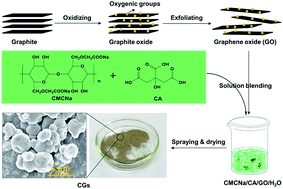Facile fabrication of carboxymethyl cellulose sodium/graphene oxide hydrogel microparticles for water purification
Abstract
Herein, carboxymethyl cellulose sodium (CMCNa)/graphene oxide (GO) hydrogel microparticles (CGs) with diameters of 2.2–3.6 μm were prepared facilely via spray drying. The as-prepared CGs were used as adsorbents for the removal of methylene blue (MB), Eosin Y and various heavy metal ions. The results revealed that the adsorption capacities of the CG with 8 wt% GO increased by 340–354% for the dyes and 350–500% for heavy metal ions, in comparison with the pristine CMCNa reference. Moreover, the microparticle structure also endowed the CGs with high adsorption kinetics as the adsorption equilibrium for all pollutants was commonly reached within 30 min. The adsorption mechanisms for dyes were due to both electrostatic and π–π interactions, while those for heavy metals were the synergistic effect of electrostatic interactions, surface complexation and ion exchange. Further investigation indicated that the adsorption isotherms and kinetics can be well fitted by the Langmuir isotherm model and the pseudo-second-order model, respectively. By adjusting the GO content and solution pH, the adsorption capacities of our CGs can be further improved. The unique adsorption properties of our CGs, together with the spray drying method, make them very promising in the mass production of broad-spectrum adsorbents for water purification.


 Please wait while we load your content...
Please wait while we load your content...